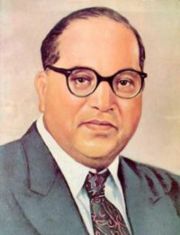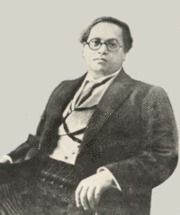 The Father of Indian Constitution Dr. B. R. Ambedkar  Bhodisatva Dr. B. R. Ambedkar
****EDUCATE, UNITE AND AGITATE****
According to B. R. Ambedkar, “Society is always composed of Classes. Their basis may differ. They may be economic or intellectual or social, but an individual in a society is always a member of a class. This is a universal fact and early Hindu society could not have been an exception to this rule, and, as a matter of fact, we know it was not. So what was the class that first to make itself into the caste, for class and caste, so to say, are next door neighbors, and it is only the span that separates the two. A Caste is an Enclosed class.”[1]
Regarding the origin of Caste, B. R. Ambedkar said that, “The study of the origin of caste must furnish us with an answer to the question-What is the class that raised this “enclosure” around itself? The customs in question were current in the Hindu society. These customs in on their strictness are obtainable only in one caste, namely the Brahmins, who occupy the highest place in the social hierarchy of the Hindu society; and as their prevalence in non-Brahmin castes is derivative of their observance are neither strict nor complete. If the prevalence of these customs in the non-Brahmin castes is derivative then it needs no argument to prove that which class is the father of the institution of caste. The strict observance of these customs and the social superiority arrogated by the priestly class in all ancient civilization are sufficient to prove that they were the originators of this “unnatural institution” founded and maintained through these unnatural means.”[2]
This feature of class is common with other societies also. About the classes present in Hindu society Ambedkar said that, “the Hindu society, in common with other societies was composed of classes and the earliest known are the {1} Brahmins or the priestly class; {2} The Kshatriya, or the military class and {3} The Vaishya, or the merchant class and {4} The Shudra, or the artisan menial class. Particular attention has to be paid to the fact that this was essentially a class system, in which individuals, when qualified, could change their class, and therefore classes did change their personnel. At some times in the history of the Hindus, the priestly class socially detached itself from the rest of the body of people and through a closed door policy became a caste by itself. The other classes being subject to the law of social division of labour underwent differentiation, some into large, other into very minute groups. The Vaishya and Shudra classes were the original inchoate plasm, which formed the sources of the numerous castes of today. As the military occupation does not very easily lend itself to very minute sub–division, the Kshatriya class could have differentiated into soldiers and administrators.”[3]
About sub-division of society he further added that, “This sub-division of a society is quite natural. But the unnatural thing about these sub-divisions is that they have lost the open-door character of the class system and have become self-enclosed units called castes. The question is: were they compelled to close their doors and become endogamous, or did they close them of their own accord? I submit that there is a double line of answer: Some closed the door: Other found it closed against them. The one is a psychological interpretation and the other is mechanistic, but they are complementary and both are necessary to explain the phenomena of caste-formation in its entirety.”[4]
So this is the brief history of castes in India. But were there any harms of this caste system? It is very important to find out the answer of this question. As above mentioned there were mainly four classes present in India. In the course of time, one new class, the fifth class, emerged from the shudra class, that was Ati-shudra or Dalits, which was lower in status than the fourth Varna. The people under the fourth Varna, known as Shudras, were sufficiently degraded in the religious books; one can imagine the situation of the people who were another step below the Shudras. That is why the Dalits have another name called, “Outcaste or Untouchables.” Dalits were deprived of the basic human rights, the right to education, and their degraded position was sanctified by the religious law books. Here are two verses from the texts of the Hindu religion: Now if a Sudra listens intentionally to (a recitation of) the Veda, his ears shall be filled with (molten) tin or lac. (Gautam Dharma Sutra 12.4). Vedas were the first religious books of the Hindus. Hindus, or Brahmins to be precise, declared Vedas as divine and hence infallible. Another verse is: If a Sudra recites (Vedic text), his tongue shall be cut out.[5]
On the pathetic condition of untouchables Ambedkar had given lot of facts. He writes that , “Under the rule of the Peshwas in the Maratha country the untouchables was not allowed to use the public street if a Hindu was coming along lest he should pollute the Hindu by his shadow. The untouchable was required to have a black thread either on his wrist or on in his neck as a sign or a mark to prevent the Hindus from getting them polluted by his touch through mistake. In Poona, the capital of the Peshwa, the untouchables was required to carry, strung from his waist, a broom to sweep away from behind the dust he treaded on lest a Hindu walking on the same should be polluted. In Poona the untouchable was required to carry an earthen pot, hung in his neck wherever he went, for holding his spit falling on earth should pollute a Hindu who might unknowingly happen to tread on it.”[6] The children of untouchables were not allowed to study in public school. Untouchables were not allowed to use public wells, to wear apparel or ornaments they like and to eat any food they like. The list of atrocities is even longer than this. In post-independent India, this list is lessen but not completely exhausted.
Very few social reformers fought against this unnatural institutions and atrocities. Mahatma Jyotirao Phule, Savitribai Phule, Chhatrapati Shahu Maharaj, Periyar E. V. Ramaswamy and B. R. Ambedkar were main of them. Ambedkar asserts that caste is not based on division of labour. It is division of labourers. As an economic organization also, caste is a harmful institution. He calls upon the Hindus to annihilate the caste which is a great hindrance to social solidarity and to set up a new social order based on the ideals of liberty, equality and fraternity in consonance with the principles of Democracy. He advocates inter-caste marriage as one of the solutions to the problem. But he stresses that the belief in the ‘shastras’ is the root cause of maintaining castes. He therefore suggests, “make every man and woman free from the thralldom of the ‘shastras’, cleanse their mind of the pernicious notions founded on the ‘shastras’ and he or she will interdine and intermarry”. According to him, the society must be based on reason and not on atrocious traditions of caste system.
From the above deliberation it is clear that the Caste is a close system and Class is an open system. Education can lead an individual to move from Caste to Class, i.e; from close system to open system. In Caste system, an individual is confined only to his or her traditional occupation. So, there is a little scope to grow. But in Class, as it is open, an individual can grow as per his or her capability. And only education can bring this change. Ambedkar had also given lot of emphasis on getting education. He said that, “Educate, Organize and Agitate”. Here he had given prime importance to education. He further added that, “The backward classes have come to realize that after all education is the greatest material benefit for which they can fight. We may forego material benefits of civilization but we cannot forego our rights and opportunities to reap the benefits of the highest education to the fullest extent. That the importance of this question from the point of view of the backward classes who have just realized that without education their existence is not safe.” He suffered a lot due to this caste system. Still in that system of discrimination, he succeeded to well educate himself.
Notes
- Moon, Vasant (Comp), Dr. Babasaheb Ambedkar Writing and Speeches, Vol. 1, p. 15, Bombay: The Education Department, Government of Maharashtra, (1979).
- Moon, Vasant (Comp), Dr. Babasaheb Ambedkar Writing and Speeches, Vol. 1, p. 15, Bombay: The Education Department, Government of Maharashtra, (1979).
- Ibid., p. 18
- Ibid., p. 18
- Gautam Dharma Sutra 12.5
- Ibid., p. 39
Author
Mr. Sanjay Kumar Pandagale,
Lecturer in Education,
Regional Institute of Education,
Shyamla Hills, Bhopal
| Mr. SANJAY KUMAR PANDAGALE
opaparaja@yahoo.co.in
sanju.rie@indiatimes.com
|

|
|

